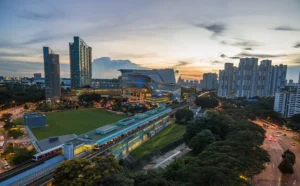In less than a century since its independence, the Indian economy has transformed itself into a force to be reckoned with. Today the country’s economy is recognised as the fifth most powerful in the world by the International Monetary Fund. From liberal government policies and initiatives to accelerate foreign direct investments in the country to the consistent efforts by the administrative bodies to provide a robust infrastructural framework, the formula behind this metamorphosis of the country is ingeniously multifaceted.
Table of Contents
Amidst the cities that have propelled the growth of the country, one whose contributions were especially noteworthy is Gurugram. The city’s transition from a collection of villages connected by haphazard dirt roads to a booming metropolis has indeed set the blueprint for the rest of the country. The city today is however saturated with a dense population, rising population, and axiomatically soaring real estate prices.
In light of this, the interest of real estate developers, investors, and end-users has been shifting towards the emerging micromarket of New Gurugram. Located right between Manesar and Delhi, New Gurugram is furnished with an enviable transit network and leading social institutions. In addition to this, not only is the micromakret home to numerous businesses from IT/ITes companies to startups, but it also has seamless access to major business and commercial hubs. It is therefore quite easy to see why New Gurugram today is touted as one of the top ten residential neighbours in the country to invest in as per a report by Knight Frank.
An Ideal Choice For Residential Investment
In the growth corridor that is New Gurguram, Sector 84 is located right at its heart, thereby harnessing all the benefits of the micromarket to its greatest potential. To enrich your understanding of why this sector is the ideal choice for you to live in with a high investment potential, we have elaborated on some advantages of this location below.
Impeccable Connectivity Framework:
It is a well-known fact that it is pivotal for a location to have an excellent transit infrastructure in place if it is to prosper. A location can have the best commercial and residential projects, but if people do not have an easily accessible framework to commute, the former would be of no avail. Now when we talk about transit framework, it is important to note that it refers to both, a schema of roadways as well as a developed public transportation system. Sector 84, New Gurgram in particular has an excellent infrastructural framework on account of its vicinity to multiple highways. From the IFCO Chowk to IGI airport to the Gurguram Railway Station, sector 84 is located in proximity to various landmark locations.
- Dwarka Expressway: The 27.6 km long, elevated expressway is located in the vicinity of Sector 84. The under-construction corridor is proposed to connect Mahipalpur in Delhi to Kherki Daula Toll Plaza in Sector 84, New Gurugram. It is intended to serve as a signal-free route to Delhi and Manesar for the residents of New Gurugram. According to industry estimates, once open to the public, the expressway has the potential to reduce up to 30-60% of the traffic on the congested Delhi-Gurugram Expressway. In addition to this, by virtue of the expressway, residents of Sector 84 will have easy access to the commercial hubs of Udyog Vihar, Cyber City, IMT Manesar, Sohna Road, and Golf Course Extension Road.
- Kundli-Manesar-Palwal Expressway: The Sector is also located less than an hour away from the Manesar-Kundli portion of the KMP Expressway, also commonly known as the Western Peripheral Expressway. This allows for a seamless transit to Punjab, Himachal Pradesh, and the northern part of Haryana which can further facilitate trade and commerce in the region.
- Other Proposed Developments: The central and state government is working ceaselessly to improve the public transport system in New Gurugram. The metro expansion project from Huda City Center looping back to Cyber City via Old Gurugram is reflective of these efforts. The project has a vision of developing a metro line along with the Dwarka Expressway, with a central station proposed to be developed near Sector 84.
- In addition to this, a plan for a new Interstate Bus Terminal connecting Gurugram to the rest of the country is also in the works. The ISBT is earmarked to be located off the Dwarka Expressway, in Sihi Village in Sector 84.
An Enviable Social Infrastructure:
The role of a robust social infrastructure in the success of a community cannot be overstated. It is only when social institutions like clinics, hospitals, shopping and recreational avenues, and educational academies are present, is it conceivable for urban habitation to flourish.
Sector 84, New Gurugram is blessed with the presence of some leading social institutions in the city. From world-class recreational zones such as Sapphire 83 Mall, Trehan Iris Broadway, and INOX Cinemas to educational institutions like Delhi Public School and Euro International School, you will have access to all in just a 10km radius. Not only this, you will also have access to best-in-class medical facilities such as Miracle Apollo Cradle for your children, and Shri Balaji Multispecialty Hospital.
Employment Opportunities Galore:
For the modern workforce, one of the major deciding factors when choosing their place of work is its location and the transit ease it might provide. With major commercial and business hubs in close proximity, not to mention the emerging micromarket of New Gurgram itself, there has been a noticeable increase in the movement of the best talent to the area. From Cyber City to Sohna Road to Udyog Vihar, the location provides seamless connectivity to the majority of business hubs in the NCR. In addition to this, the sector is also located within a 10 km radius of the Industrial Model Township, Manesar which today is a nexus of industries such as automobile, pharmaceuticals, textiles, etc.
High Living Standards:
Though the pandemic has long been over, the ramifications for changes it has inspired the needs and wants of the homeowners is definitely going to persist for the foreseeable future. One such change that the pandemic brought in is a shift to a work-from-home or hybrid model. This has led to an increase in demand for spacious living spaces, wherein there is enough space for workstations. In addition to this, the demand for luxury segment in housing is also on the rise, in response to growing incomes and a desire to own living spaces with all modern amenities.
In stark opposition to the skyrocketing prices in Delhi and Central Gurugram, New Gurugram provides you the opportunity to own a luxury property at a relatively affordable price range. For instance, as per a study conducted by Anarock, while prices in New Gurugram were at ₹ 6,275 per sq. ft, they were ₹ 6,920 per sq. ft on Sogna Road, in FY22. While the presence of leading business conglomerates, IT/ITes companies, and Unicorn startups in the area ensure plenty of employment opportunities, the thriving social infrastructure ensures an elevated living standard. All in all, this forms the perfect concoction for an elevated lifestyle that is coveted by many today.
To sum it up, homeowners today look for a location with a progressive transit network, road and highway framework, distinguished social institutions, and relatively affordable pricing for luxury properties. New Gurugram in particular, Sector 84 not only ticks but exceeds this criteria, making it the ideal place to make your dream of owning a luxury property come true, all the while investing in a high-yielding locale.








